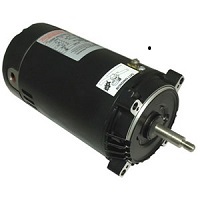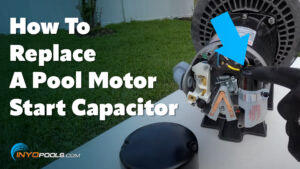When it comes to a failed pool pump motor, the pool owner is faced with that eternal question, “repair or replace?”
 The first thing to check is if it’s still under warranty. For a pump that still has the original motor, you would contact the manufacturer of the entire pump. If you have already replaced the motor before, you would contact the manufacturer of the motor. As most pump and motor warranties are only 1 year, you might be out of luck but it’s worth double checking the purchase date.
The first thing to check is if it’s still under warranty. For a pump that still has the original motor, you would contact the manufacturer of the entire pump. If you have already replaced the motor before, you would contact the manufacturer of the motor. As most pump and motor warranties are only 1 year, you might be out of luck but it’s worth double checking the purchase date.
Assuming you are out of warranty, you have a decision to make. A replacement motor is generally going to cost you in the neighborhood of $150 – $300 depending on the horsepower. Add another $15 – $30 for the absolutely necessary, non-negotiable new shaft seal. Can you repair it instead for less? Probably. Is it worth it? Maybe.
 Here’s the deal with repairing pool motors. You have to figure out the actual problem first. Is it the capacitor, the bearings, an electrical short? If you’re mechanical and handy and know your way around a pool pump, then it could be fairly easy for you to diagnose the issue and even repair it yourself.
Here’s the deal with repairing pool motors. You have to figure out the actual problem first. Is it the capacitor, the bearings, an electrical short? If you’re mechanical and handy and know your way around a pool pump, then it could be fairly easy for you to diagnose the issue and even repair it yourself.
If you’re none of the above, you will need to have a tech come look at it or take it to a motor shop – and that alone could cost you before any parts are even replaced. You also need to find a repair person that you trust so you can be confident the real issue is being addressed. From what we hear from pool owners across the country, that’s a rare find.
 Another thing to weigh out is the age of the motor and if it’s worth investing any money into it. Age is relative to where you are located. A pump running 365 days a year in warmer climes is going to be “older” than the same pump with the same installation date in a colder region where pools are closed most of the year. So if it’s over 2 – 3 years old in the Sun Belt or 5 – 6 years old up north, most likely it will not pay to repair it. Many pool pump motors last less than 5 years; the last thing you want to do is put $100 worth of repairs into a motor that was destined to die in 6 months anyway. Plus none of your replacement parts will carry a warranty whereas a complete new motor will.
Another thing to weigh out is the age of the motor and if it’s worth investing any money into it. Age is relative to where you are located. A pump running 365 days a year in warmer climes is going to be “older” than the same pump with the same installation date in a colder region where pools are closed most of the year. So if it’s over 2 – 3 years old in the Sun Belt or 5 – 6 years old up north, most likely it will not pay to repair it. Many pool pump motors last less than 5 years; the last thing you want to do is put $100 worth of repairs into a motor that was destined to die in 6 months anyway. Plus none of your replacement parts will carry a warranty whereas a complete new motor will.
 Especially with online motor prices being more competitive these days (remember, free shipping from Inyo Pools!), it is definitely worth a few searches and a few phone calls to compare prices for replacement vs. repair. I’ve heard of pool owners getting motor repair quotes locally that are $100 more than the cost of a new motor and seal. I’ve also heard of handy DIYers who buy a few bearings on the cheap, replace them, and get up and running again. It really is a case-by-case scenario as there are so many variables affecting each individual pump.
Especially with online motor prices being more competitive these days (remember, free shipping from Inyo Pools!), it is definitely worth a few searches and a few phone calls to compare prices for replacement vs. repair. I’ve heard of pool owners getting motor repair quotes locally that are $100 more than the cost of a new motor and seal. I’ve also heard of handy DIYers who buy a few bearings on the cheap, replace them, and get up and running again. It really is a case-by-case scenario as there are so many variables affecting each individual pump.
The bottom line – I believe in general you will get more value and longevity out of replacing the complete motor. Motor replacement also presents you with the opportunity to upgrade to a more energy efficient system – perhaps a lower horsepower if your pump is over-sized as so many are, or a dual speed or variable speed. In many cases, you can easily recoup your motor expense through energy savings. To get an idea of variable speed pump savings, try Pentair’s Savings Calculator. This calculator is based on their IntelliFlo pump but will give you a general idea of energy efficiency’s impact on your wallet.
If you are in the throes of the repair / replace debate and want one of our techs to chime in, please feel free to call us at 877-372-6038.














Leave a Reply